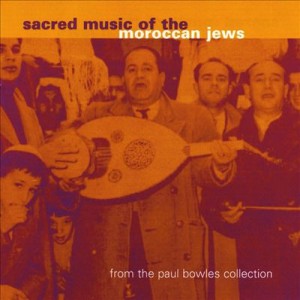 In 1959, the American author and composer Paul Bowles recorded several hours of religious singing by Jews in two Moroccan cities. These Jewish communities were in transition; having survived World War II, their population had started trickling away to the decade-old nation of Israel. The exodus was to be nearly total within a few more years.
In 1959, the American author and composer Paul Bowles recorded several hours of religious singing by Jews in two Moroccan cities. These Jewish communities were in transition; having survived World War II, their population had started trickling away to the decade-old nation of Israel. The exodus was to be nearly total within a few more years.
This two-CD set presents nearly two hours of that music from four different sessions. It’s an important historical document, but probably of little musical interest to any but scholars.
The music was recorded in synagogues, and therefore is entirely unaccompanied by instruments. Nearly one full CD consists of a part of a Sabbath service. Other sessions include sacred Hebrew poetry set to popular Egyptian and Algerian tunes, and Hebrew poems set to Andalusian music from two different urban congregations.
The first 17 tracks on the first CD are from the Sabbath service. Some are call-and-response vocals led by the cantor, a mellifluous baritone. Most are led by other vocalists, mostly tenors. Some are solo, some include the congregation. The singers supply the missing instrumental parts with non-verbal syllables: “de-di-de-di-de-dums” and “yanna-yannas” right out of the “Fiddler on the Roof” songbook.
The first part of the second CD comprises several poems set to music, all in the same mode or key, flowing from one to another without a break. Most feature a solo tenor, who is joined by other voices on a few of the pieces. These have an almost madrigal-like quality with repeated phrases sometimes in harmony and sometimes in unison.
The greater part of the second CD is a congregation singing a suite of religious poems, led by a baritone vocalist, again with no interruptions or breaks between songs. The leader is a pretty good singer, but the group singing has a charmingly ragged amateurish quality, with some of the accompanists coming in off-key or searching for the melody or words.
It’s too bad all the recordings were made in a synagogue, because some instrumental accompaniment would have added interest and needed rhythm. As it is, the cover photo of a group of men singing and playing instruments, including a type of lute, a tambourine and a violin, is misleading.
I can’t imagine anyone listening to these recordings recreationally. This is one for the libraries and other special collections.
(Rounder, 2000)
